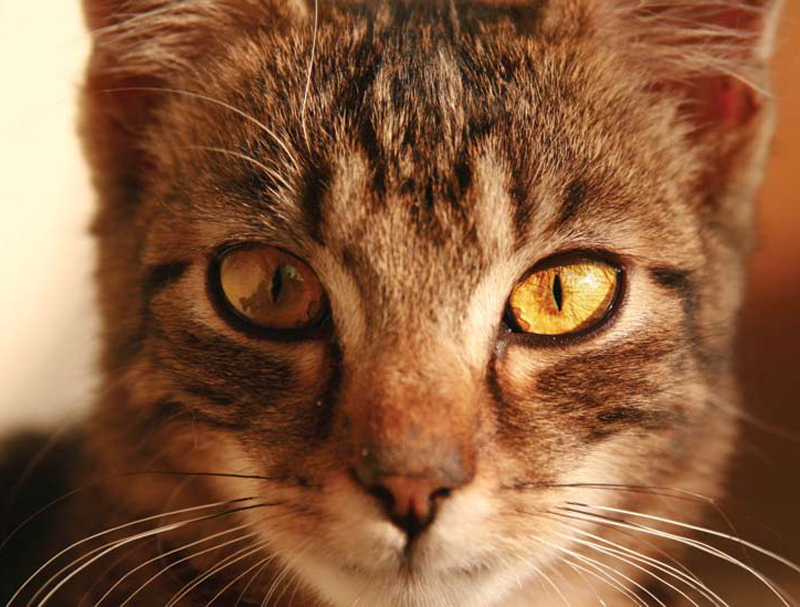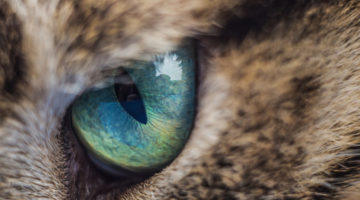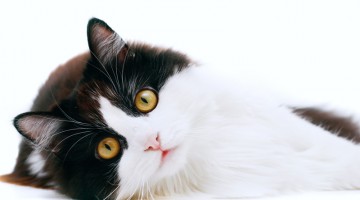Few things are more beautiful than the bright eyes of a happy healthy cat. Aside from being gorgeous, your feline’s peepers can tell you quite a lot about her well being.
It’s said the eyes are the window to the soul. In cats, they can also be the window to underlying health issues. Are your cat’s eyes bright and clear, or is there redness or chronic discharge? What does it mean if your cat’s third eyelids are visible? Is a change in eye color or pupil size reason for concern?
The Conjunctivitis Connection
Numerous infectious diseases cause eye problems in cats. Most are due to upper respiratory viruses like rhinotracheitis (a herpesvirus), calicivirus and chlamydia. All three cause, among other things, conjunctivitis (swelling of the conjunctive tissues). Kittens, older cats and those living in multi-cat environments are more susceptible. Because rhinotracheitis is a herpesvirus, a cat that had it as a kitten may have recurrent flare-ups when stressed.
If the conjunctivitis is mild, it can be treated at home. Often, though, the eye/s will become stuck shut and that can result in corneal ulcers. Oral antibiotics are usually not effective because all three of these upper respiratory problems are viruses. If your kitten or cat is suffering from conjunctivitis, it is important to keep the eye moist and lubricated. An antibiotic ointment will do this, but I have always used artificial tear lubricant whenever I have a kitten with conjunctivitis.
There are vaccinations against rhinotracheitis, calicivirus and chlamydia. The first two are core vaccines and should be received by all kittens, but the chlamydia vaccine is usually not recommended due to potential side effects. As is the case with all vaccinations, they do not offer total protection and may cause subsequent chronic disease. Corneal ulcers, should they occur, are serious and should be treated by a veterinarian. I have had great success in treating corneal ulcers using both homeopathy and the application of liquid food grade vitamin E and vitamins A/D in the eye several times a day. Vitamin E in particular helps heal scarring.
Many veterinarians will recommend supplementation with the amino acid lysine to help with herpesvirus flareups. I have had more success supplementing my cats’ diet with taurine, an essential amino acid for felines. A diet insufficient in taurine results in central retinal degeneration (eye lesions) that can lead to blindness. Taurine can also protect against cataracts and diseases of the retina.
When your cat is getting ready to pounce on a toy, she may move her head rapidly from side to side. It helps her better judge the distance between herself and her “prey”.
More Red Flags
Glaucoma can be difficult to diagnose in cats because their eyes are able to withstand much greater pressure elevation without visible evidence of disease.
Signs to watch for: Increased size of the cat’s eye and/or pupil, a cloudy appearance.
Cataracts are relatively rare in cats and usually related to complications from diabetes or uveitis. Some purebred breeds are more susceptible than others.
Signs to watch for: A distinct disparity in eye clarity, increased opacity, cloudiness or a change in pupil size. Uveitis affects the uvea, which consists of three parts – the iris, the ciliary body (the tissue immediately behind the iris) and the choroids (the vascular layer in the back of the eye that supplies nutrition to the retina).
Uveitis may occur spontaneously or secondary to diseases such as feline leukemia, FIV or FIP.
Signs to watch for: A change in iris color may indicate uveitis or iris melanomas. With both of these, cats most commonly develop a brown color change that affects much of the iris.
All the above conditions are serious and may lead to blindness or eye removal. If you notice any changes in your cat’s eyes, she should be seen by a veterinarian. Take time to stare into your cat’s eyes on a daily basis. Not only will you enjoy the visual interaction, but it also gives you a chance to notice if there’s anything amiss with those beautiful orbs.
The Third Eyelid
Cats have a whitish or pink membrane, sometimes called the third eyelid, at the inner corner of each eye. Its purpose is to protect the eye and retain moisture. This “nictating membrane” normally stays concealed but may intermittently appear when a cat is drowsy and content. If it remains partially visible, protrudes or appears swollen or red, contact your veterinarian. The third eyelid of some breeds, especially the Orientals, may remain visible with no apparent signs or presence of disease. In general, however, continued visibility of the third eyelid is an indication of illness.







No Comment